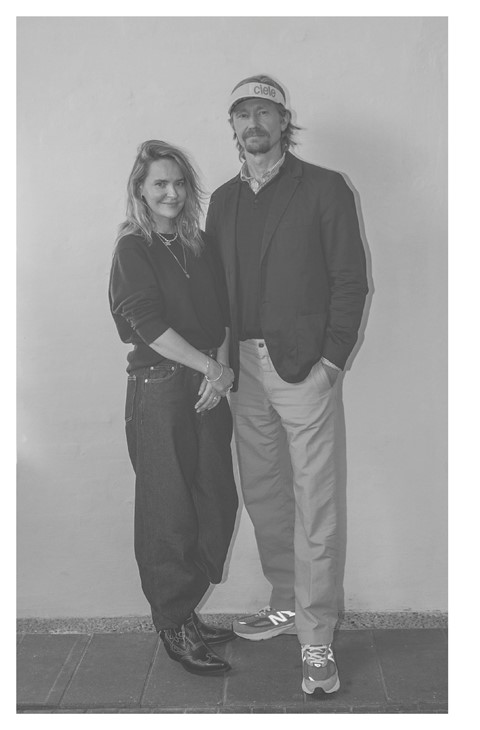As The Ganni Playbook is published, the brand’s former CEO Nicolaj Reffstrup talks about changing fashion’s sustainability culture for the better
From puffy-sleeved dresses to cowboy boots and leopard print, Ganni, under the creative direction of Ditte Reffstrup, is everywhere. But the brand’s DNA is as much about responsible practices as it is about free-spirited, bike-riding Ganni Girls. Ditte’s partner, Nicolaj Reffstrup, has a tech background and was Ganni’s CEO for a decade, quitting that role to focus on sustainability endeavours and a green investment fund focused on green tech solutions.
Speaking to AnOther, Nicolaj says he often mingles amongst fashion’s ‘C-Levels’ [executives] at events like the Global Fashion Summit in Copenhagen, and has long been frustrated by “the inertia built into the system”. Terrified by the imminent climate crisis, he initiated sustainable measures at Ganni years ago, while others “waited for each other to start something; or an industry standard; or for regulation”. Earnest in a charmingly Danish way, Nicolaj says other brands view prioritising sustainability as a sacrifice. “It’s frustrating because I meet a lot [of people] that would like to do the right thing, but are held back by budgets. It’s not an easy situation to unlock.” But that’s his aim with The Ganni Playbook – co-written with fashion tech consultant and writer Brooke Roberts-Islam – on Ganni’s environmental approach. In the tech sector, he says, discoveries are shared; “and we make progress as an ecosystem”, while fashion has a closed culture he’d like to change.
Interested in climate change since university, he joined Ditte at Ganni in 2009. In 2013; “we employed a CSR manager, to deal with workers’ rights; code of conduct; use of chemicals. By 2016, we started mapping our carbon footprint.” The majority came from manufacturing. Offsetting carbon emissions was just the beginning. They set 44 targets, from tracing supply chains to reducing, then eliminating plastic packaging to using more deadstock and recycled materials. “We think of something big for three to five years’ time, then break it down to smaller goals with deadlines,” says Nicolaj.

The design team share responsibility, with strict policies on materials. Their best-selling Western boot had to be axed in two colourways when the brand phased out virgin leather, now only using recycled leather or biotech alternatives. “Sometimes you have to kill your darlings,” explains Nicolaj. Recent experiments with recycling may cause them to switch the printing dyes and inks for T-shirts, to facilitate circularity.
The biggest lesson of the book is the need for mindset change. “Because there’s no money to be made short-term, people don’t do anything,” Nicolaj says, “but it’s the right thing to do.” Counter-intuitively, he says that “although responsible methods cost more, it’s not as expensive – and it can be easier – than you might fear”. Ganni spends only one per cent of total sales on their sustainable initiatives.
With each success, Nicolaj sets more ambitious targets. Around 2017, the brand took on investment to grow significantly. Carbon emissions increased, contrary to their goals. “Our initiatives take time to implement and even longer to see results”, Nicolaj explains, although emissions peaked in 2021, and are now down by seven per cent in absolute terms. They’re now aiming for a 50 per cent reduction by 2027, having switched from ‘offsetting’ to ‘insetting’ – lowering emissions via use of renewables. They’ve installed solar panels in some supplier factories. However, Ganni use up to 45 suppliers, shared with multiple other brands. How do you cover all of them? “If everyone contributed, we could get there quickly,” he explains.

It’s a similar story regarding garment workers. Ganni aims for all Tier 1 workers to have a living wage by 2025, but it’s not been straightforward. “It sounded obvious to start – but it’s been more complex than we realised,” says Nicolaj. Right now, suppliers will only be paid a premium for Ganni orders, rather than a living wage overall – unless other brands employing them contribute too.
As for the future, Nicolaj is an oracle on new technologies to reform the industry, like textile recycling. Ganni plans to become fully circular, with garments designed for future fibre-to-fibre recycling. Legislation is also anticipated, which will compel brands to become more responsible or face penalties. Nicolaj researches and invests in eco start-ups, saying that “maybe one day we will be able to create ‘impact-free’ fashion. Something new, cool and sexy – but [that] leaves the world in a better way. You’d need crazy innovative materials and a totally circular business model.” He describes Rubi Laboratories making “cellulose out of sequestered carbon. If they’re successful, you could make a viscose that sucks up carbon, making carbon negative clothing, which would be the ultimate.” He shakes his head. “Can you imagine actually consuming your way to a better climate?” Who knows? After all, everything started as somebody’s dream.
The Ganni Playbook by Nicolaj Reffstrup and Brooke Roberts-Islam is published by Penguin Business, and is out now.

